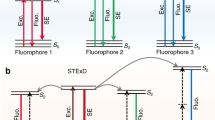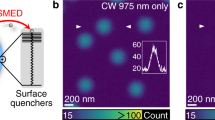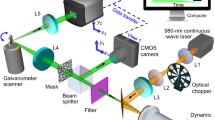Abstract
Stimulated-emission depletion (STED) microscopy has profoundly extended our horizons to the subcellular level1,2,3. However, it remains challenging to perform hours-long, autofluorescence-free super-resolution imaging in near-infrared (NIR) optical windows under facile continuous-wave laser depletion at low power4,5. Here we report downshifting lanthanide nanoparticles that enable background-suppressed STED imaging in all-NIR spectral bands (λexcitation = 808 nm, λdepletion = 1,064 nm and λemission = 850–900 nm), with a lateral resolution of below 20 nm and zero photobleaching. With a quasi-four-level configuration and long-lived (τ > 100 μs) metastable states, these nanoparticles support near-unity (98.8%) luminescence suppression under 19 kW cm−2 saturation intensity. The all-NIR regime enables high-contrast deep-tissue (~50 μm) imaging with approximately 70 nm spatial resolution. These lanthanide nanoprobes promise to expand the application realm of STED microscopy and pave the way towards high-resolution time-lapse investigations of cellular processes at superior spatial and temporal dimensions.
This is a preview of subscription content, access via your institution
Access options
Access Nature and 54 other Nature Portfolio journals
Get Nature+, our best-value online-access subscription
$29.99 / 30 days
cancel any time
Subscribe to this journal
Receive 12 print issues and online access
$259.00 per year
only $21.58 per issue
Buy this article
- Purchase on Springer Link
- Instant access to full article PDF
Prices may be subject to local taxes which are calculated during checkout




Similar content being viewed by others
Data availability
Source data are provided with this paper. The data that support the findings of this study are available within the article and its Supplementary Information. Additional data are available from the corresponding authors upon request.
References
Hell, S. W. Far-field optical nanoscopy. Science 316, 1153–1158 (2007).
Hell, S. W. & Wichmann, J. Breaking the diffraction resolution limit by stimulated emission: stimulated-emission-depletion fluorescence microscopy. Opt. Lett. 19, 780–782 (1994).
Vicidomini, G. et al. Sharper low-power STED nanoscopy by time gating. Nat. Methods 8, 571–573 (2011).
Klar, T. A., Jakobs, S., Dyba, M., Egner, A. & Hell, S. W. Fluorescence microscopy with diffraction resolution barrier broken by stimulated emission. Proc. Natl Acad. Sci. USA 97, 8206–8210 (2000).
Willig, K. I., Harke, B., Medda, R. & Hell, S. W. STED microscopy with continuous wave beams. Nat. Methods 4, 915–918 (2007).
Chen, B.-C. et al. Lattice light-sheet microscopy: imaging molecules to embryos at high spatiotemporal resolution. Science 346, 1257998 (2014).
Bates, M., Huang, B., Dempsey, G. T. & Zhuang, X. Multicolor super-resolution imaging with photo-switchable fluorescent probes. Science 317, 1749–1753 (2007).
Betzig, E. et al. Imaging intracellular fluorescent proteins at nanometer resolution. Science 313, 1642–1645 (2006).
Fölling, J. et al. Fluorescence nanoscopy by ground-state depletion and single-molecule return. Nat. Methods 5, 943–945 (2008).
Gwosch, K. C. et al. MINFLUX nanoscopy delivers 3D multicolor nanometer resolution in cells. Nat. Methods 17, 217–224 (2020).
Klar, T. A. & Hell, S. W. Subdiffraction resolution in far-field fluorescence microscopy. Opt. Lett. 24, 954–956 (1999).
Eggeling, C. et al. Direct observation of the nanoscale dynamics of membrane lipids in a living cell. Nature 457, 1159–1162 (2008).
Vicidomini, G., Bianchini, P. & Diaspro, A. STED super-resolved microscopy. Nat. Methods 15, 173–182 (2018).
Hoebe, R. et al. Controlled light-exposure microscopy reduces photobleaching and phototoxicity in fluorescence live-cell imaging. Nat. Biotechnol. 25, 249–253 (2007).
An, Z. et al. Stabilizing triplet excited states for ultralong organic phosphorescence. Nat. Mater. 14, 685–690 (2015).
Bünzli, J.-C. G., Chauvin, A.-S., Kim, H. K., Deiters, E. & Eliseeva, S. V. Lanthanide luminescence efficiency in eight-and nine-coordinate complexes: role of the radiative lifetime. Coord. Chem. Rev. 254, 2623–2633 (2010).
Malta, O. Mechanisms of non-radiative energy transfer involving lanthanide ions revisited. J. Non Cryst. Solids 354, 4770–4776 (2008).
O’Brien, J. J. & O’Brien, J. F. The Laporte selection rule in electronic absorption spectroscopy. J. Coll. Sci. Teach. 29, 138–140 (1999).
Wisser, M. D. et al. Strain-induced modification of optical selection rules in lanthanide-based upconverting nanoparticles. Nano Lett. 15, 1891–1897 (2015).
Jackson, S. D. Towards high-power mid-infrared emission from a fibre laser. Nat. Photonics 6, 423–431 (2012).
Fernandez-Bravo, A. et al. Continuous-wave upconverting nanoparticle microlasers. Nat. Nanotechnol. 13, 572–577 (2018).
Chen, X. et al. Confining energy migration in upconversion nanoparticles towards deep ultraviolet lasing. Nat. Commun. 7, 10304 (2016).
Lee, C. et al. Giant nonlinear optical responses from photon-avalanching nanoparticles. Nature 589, 230–235 (2021).
Lando, M., Kagan, J., Linyekin, B. & Dobrusin, V. A solar-pumped Nd:YAG laser in the high collection efficiency regime. Opt. Commun. 222, 371–381 (2003).
Wang, F., Deng, R. & Liu, X. Preparation of core–shell NaGdF4 nanoparticles doped with luminescent lanthanide ions to be used as upconversion-based probes. Nat. Protoc. 9, 1634–1644 (2014).
Liu, Y. et al. Amplified stimulated emission in upconversion nanoparticles for super-resolution nanoscopy. Nature 543, 229–233 (2017).
Rittweger, E., Han, K. Y., Irvine, S. E., Eggeling, C. & Hell, S. W. STED microscopy reveals crystal colour centres with nanometric resolution. Nat. Photonics 3, 144–147 (2009).
Han, K. Y., Kim, S. K., Eggeling, C. & Hell, S. W. Metastable dark states enable ground state depletion microscopy of nitrogen vacancy centers in diamond with diffraction-unlimited resolution. Nano Lett. 10, 3199–3203 (2010).
Hanne, J. et al. STED nanoscopy with fluorescent quantum dots. Nat. Commun. 6, 7127 (2015).
Gao, P., Prunsche, B., Zhou, L., Nienhaus, K. & Nienhaus, G. U. Background suppression in fluorescence nanoscopy with stimulated emission double depletion. Nat. Photonics 11, 163–169 (2017).
Koechner, W. Solid-State Laser Engineering 38–101 (Springer, 2006).
White, J. O. Parameters for quantitative comparison of two-, three-, and four-level laser media, operating wavelengths, and temperatures. IEEE J. Quantum Electron. 45, 1213–1220 (2009).
Rehor, I. & Cigler, P. Precise estimation of HPHT nanodiamond size distribution based on transmission electron microscopy image analysis. Diam. Relat. Mater. 46, 21–24 (2014).
Han, K. Y. et al. Three-dimensional stimulated emission depletion microscopy of nitrogen-vacancy centers in diamond using continuous-wave light. Nano Lett. 9, 3323–3329 (2009).
Gu, Y. et al. High-sensitivity imaging of time-domain near-infrared light transducer. Nat. Photonics 13, 525–531 (2019).
Chen, C. et al. Multi-photon near-infrared emission saturation nanoscopy using upconversion nanoparticles. Nat. Commun. 9, 3290 (2018).
Jin, D. et al. Nanoparticles for super-resolution microscopy and single-molecule tracking. Nat. Methods 15, 415–423 (2018).
Acknowledgements
This work is supported by the National Key R&D Program of China (no. 2018YFA0902600 and no. 2018YFB1107200), the National Natural Science Foundation of China (21635002, 21771135, 21871071 and 61975123), the Ministry of Education, Singapore (MOE2017-T2-2-110), the Agency for Science, Technology and Research (A*STAR) (grant no. A1883c0011 and no. A1983c0038), National Research Foundation, the Prime Minister’s Office of Singapore under its NRF Investigatorship Programme (award no. NRF-NRFI05-2019-0003), the National Basic Research Program of China (973 Program, grant no. 2015CB932200), Zhangjiang National Innovation Demonstration Zone (ZJ-2019-ZD-005) and the Guangdong Provincial Innovation and Entrepreneurship Project (grant no. 2016ZT06D081). We thank X. Zhao, J. Chen and Z. Mu for technical assistance with the TEM imaging and NIR spectral measurements. We also thank J. Hong for absorption spectra measurements.
Author information
Authors and Affiliations
Contributions
L.L. and X. Liu conceived and designed the project. X. Liu, X. Li, M.G. and B.X. supervised the project and led the collaboration efforts. L.L. synthesized the nanocrystals and conducted the numerical simulations with contribution from L.Z., Q.Z. and Z.F. Optical experiments and super-resolution imaging were conducted by L.L., Z.F. and Y.W. The preparation of mouse-brain slices and cell labelling was the responsibility of Z.Y., M.J.Y.A., T.D.C. and H.F. The density functional theory calculations were conducted by X.Q. The manuscript was written by L.L., Z.F. and X. Liu. All authors participated in the discussion and analysis of the manuscript.
Corresponding authors
Ethics declarations
Competing interests
The authors declare no competing interests.
Additional information
Peer review information Nature Nanotechnology thanks the anonymous reviewers for their contribution to the peer review of this work.
Publisher’s note Springer Nature remains neutral with regard to jurisdictional claims in published maps and institutional affiliations.
Supplementary information
Supplementary Information
Supplementary Figs. 1–12, Discussion and Table 1.
Source data
Source Data Fig. 1
Statistical source data.
Source Data Fig. 2
Statistical source data.
Source Data Fig. 3
Statistical source data.
Source Data Fig. 4
Statistical source data.
Rights and permissions
About this article
Cite this article
Liang, L., Feng, Z., Zhang, Q. et al. Continuous-wave near-infrared stimulated-emission depletion microscopy using downshifting lanthanide nanoparticles. Nat. Nanotechnol. 16, 975–980 (2021). https://doi.org/10.1038/s41565-021-00927-y
Received:
Accepted:
Published:
Issue Date:
DOI: https://doi.org/10.1038/s41565-021-00927-y
This article is cited by
-
Directive giant upconversion by supercritical bound states in the continuum
Nature (2024)
-
Dual-band polarized upconversion photoluminescence enhanced by resonant dielectric metasurfaces
eLight (2023)
-
Proof of crystal-field-perturbation-enhanced luminescence of lanthanide-doped nanocrystals through interstitial H+ doping
Nature Communications (2023)
-
Mastering lanthanide energy states for next-gen photonic innovation
Science China Chemistry (2023)
-
Upconversion nanoparticles for super-resolution quantification of single small extracellular vesicles
eLight (2022)



